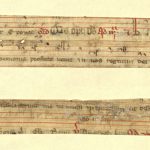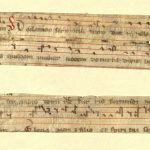For the description of the fragment’s former host volume see the online catalogue of the Library of the HAS (ALEPH), amongst Old Books – Rare Books (RBK):
Based on the content analysis it is certain, that the two thin strips of parchment were slit from the same leaf of the former codex. There may have been only a maximum of two lines with text and music between the two fragments, the upper and bottom part of the leaf are missing 3 lines altogether. The fragments kept the chants of the Little Hours of the third Sunday of Lent: the antiphon of the Prime and almost the entire Terce can be reconstructed from the two stripes of the recto, on the verso fragments a part of the Office from the middle of the None to the end of the second Vespers is visible. Mediaeval Office sources gave the chants of this season in different editorial styles: the differences are showing mostly in the detailedness of the Little Hours and in the choice and order of responsories and antiphons of certain hours. The fragments contain an above average detailed assortment of chants: it contains not only the antiphons but the usual “half-long” responsories with their verse and doxology for every Little hour. The Magnificat-antiphon (Extollens quaedam) of the second vespers is written before the responsory (Esto nobis) preceding it in the liturgical sequence. The assignment of the antiphons Dum fortis armatus and Si in digito to the Prime and Terce is outstandingly unusual: we have never came across of this assignment and order of antiphons in any of the yet examined sources. The antiphon Si in digito is usually the Benedictus antiphon of the Lauds, the Dum fortis is usually the antiphon of the Prime in most of the sources. It is possible, that this case is a scribal error.
Zsuzsa Czagány



